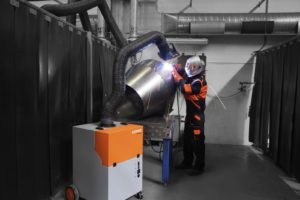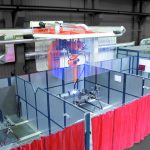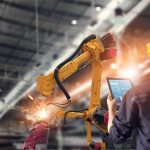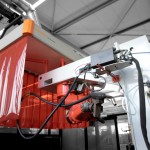Occupational health and safety in chemical plant construction: 7 measures for effective welding fume extraction
Welding processes are elementary in chemical plant construction. But large parts and changing workplaces pose special challenges for occupational health and safety. Welding fume extraction is of particular importance for protecting the employees. Further measures are recommended for the sector.
Without welding there are no optimal joints; without welding, it is impossible to achieve a high level of tightness in containers: Joining techniques are still indispensable in chemical plant construction today. In order for chemical media to be optimally transported and stored, welding ensures robust, durable joints in apparatus, containers or ducting systems. However, it is precisely in this joining process that the welding fumes pose a health hazard for the employees involved. To effectively protect employees in chemical plant construction from health hazards, an occupational health and safety concept with a mix of effective measures is more important today than ever before.
Challenges in chemical plant construction
The decisive factor here is the special requirements for protective welding equipment in chemical plant construction. These requirements pose particular challenges for the practical implementation of occupational health and safety measures in metalworking companies. In this sector, this is due in particular to the following circumstances:
- The manufacture of large containers, intermediate storage containers and ducting systems predominantly involves processes that are difficult to handle. Components such as metal plates and profiles usually have a thickness range of 3 to 30 millimetres here, with individual dimensions of even up to 12 metres. Due to the often difficult geometries and large dimensions of the components, the processing operations in chemical plant construction are characterised by frequently changing workplaces. In addition, the heavy components often have to be positioned with a crane. In chemical plant construction, local exhaust ventilation (which is always preferable) is therefore not so easy to implement because it is often not possible to extract at the point of origin.
- In addition, the MAG welding process (metal active gas welding) dominates the processing of non-alloy and high-alloy steels in the industry. This has a high to very high hazard potential.
- Furthermore, components are often made of structural steel with a high manganese content. The processing of stainless steels, which can have a carcinogenic effect, also plays an additional role. The use of extraction technology is therefore of great importance.
A mix of measures is required for the detection of hazardous substances in chemical plant construction

Nevertheless, the question arises as to which extraction units are suitable for chemical plant construction. There is not ONE single solution here, as different occupational health and safety measures offer solutions depending on the conditions described. Because the switch to low-emission processes or materials in chemical plant construction mainly fails in practice, the use of effective welding fume extraction is decisive in minimising hazards, depending on the respective components and materials.
3. Torch-integrated extraction in chemical plant construction
Because the sector requires a high degree of mobility when welding, welders need to be able to easily carry the extraction unit with them. Torch-integrated extraction – where the capture of hazardous substances is directly on the welding torch just above the protective gas nozzle – is particularly suitable for this main application of welding processes in chemical plant construction. For a long time, such systems were considered too heavy and unwieldy among welders. A new generation of extraction torches now creates a high level of operating comfort and also offers further advantages. Because, in order to capture the welding fumes in the best possible way, the extraction system must be optimally matched to the technical parameters of the respective welding torch. Digital variants of torch-integrated extraction systems have a stored database with the torch characteristics of different manufacturers.
2. Other mobile extraction units

In addition to torch-integrated extraction, mobile extraction units that collect hazardous substances via an extraction nozzle or funnel or extraction arm with extraction hood are also suitable. These systems should also be used, above all, when smaller components are involved at constant workplaces with a more restricted radius of movement. Ease of handling for the welder is important. Extraction arms, for example, should be self-supporting and it should be possible to rotate the extraction hoods by 360 degrees. Integrated LED lighting also provides a better view of the workpiece. If smaller welds are required at fixed workplaces, extraction by means of an extraction arm and extraction hood is the most frequently used variant. It provides the highest extraction rates. Compared to conventional solutions, flange-shaped extraction hoods achieve (Click here for an interview about a new extraction hood with music option) a larger extraction range due to their flow design and thus reduce the manual tracking by the welder.
3. General ventilation systems as a supplement to source extraction
If limit values cannot be sufficiently ensured with occupational health and safety measures such as torch-integrated or mobile extraction, the supplementary use of general ventilation systems is recommended. These systems support source extraction to protect the surrounding employees as well. They extract smoke-laden air at a height of about three metres, filter the air and feed it back in all around at ground level.
4. Spatially separate working areas
In addition to the use of extraction technology, so-called organisational measures are becoming increasingly important in chemical plant construction. This includes the spatial separation of welding and cutting working areas. This prevents hazardous substances from spreading to the rest of production in the first place. This is achieved, for example, by means of a complete separation of work areas or special welding booths.
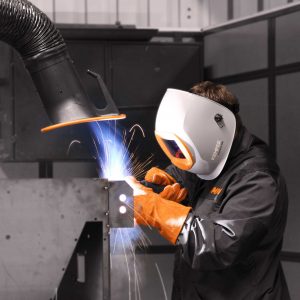
5. Respirators recommended for welders
Due to the fact that some components are difficult to access, additional protective measures for welders are recommended. If the protective measures mentioned above are not sufficient, the following should be considered: Equip welders themselves with appropriate respiratory protection masks as part of personal protective welding equipment. Fan-assisted or forced-ventilated welding helmets also protect against welding fumes that contain carcinogenic substances.
6. Robot ‘colleagues’ also want to be protected
Spatial issues are also important in the use of automated welding processes in chemical plant construction. To protect the operator and also employees at surrounding workplaces, companies must take appropriate organisational measures. The spatial separation of processes for processing low-alloy and high-alloy steels presents another effective occupational health and safety measure due to the different emission classes.
7. Special occupational health and safety measures for stainless steel welding
When welding in chemical plant construction, the processing of high-alloy steels is of particular importance. This is because the containers and apparatus often have to comply with high cleanliness principles. But welding high-alloy steel produces carcinogenic hazardous substances that are classified in the highest emission groups and thus have the highest hazard potential. Nickel oxides, for example, are highly carcinogenic. Extraction systems with W3 certification are mandatory for effective extraction and recirculation of the cleaned air into the working area.



